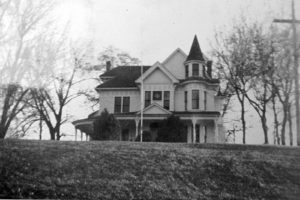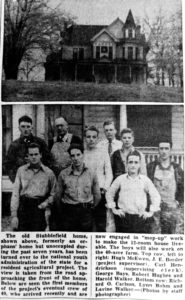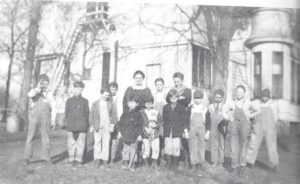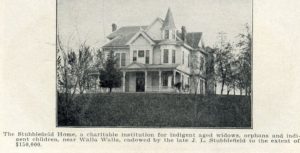Welcome to the Stubblefield Home History Website
 In 1902, prominent Walla Walla pioneer Joseph Stubblefield died and left a will providing for the establishment and operation of a home for “fatherless or motherless and indigent children, and worthy elderly indigent widows.”
In 1902, prominent Walla Walla pioneer Joseph Stubblefield died and left a will providing for the establishment and operation of a home for “fatherless or motherless and indigent children, and worthy elderly indigent widows.”
The trustees of his estate purchased the residence of W.W. Baker for this purpose. Baker was the president of Baker-Boyer Bank and son of pioneer Dorsey Baker. The large mansion was located on the hill at the south end of what is now Home Avenue. It was designed and built by Baker in 1890. The surrounding forty acres were landscaped by the Bakers’ nephew John Langdon, who lived with them.
On November 16, 1904, the Stubblefield Home for orphans and widows opened there and was rapidly filled. The facility was able to house twenty-five people in addition to a live-in superintendent and matron. It mostly accommodated children, with only three widows living there at any one time.
The boys were taught to work as farmers and gardeners on the large acreage, while the girls learned household duties, including canning of fruits and vegetables for which they won awards at agricultural fairs.
After 27 years of service to orphans and widows, the Home was closed in 1931 due to financial reverses suffered by the Stubblefield Trust resulting from a drought and the Great Depression.
Use as a National Youth Administration Residential Agricultural Project
 In 1939, the Stubblefield Home and its grounds were made available to the federal government’s National Youth Administration for use as a residential agricultural project.
In 1939, the Stubblefield Home and its grounds were made available to the federal government’s National Youth Administration for use as a residential agricultural project.
The NYA was a New Deal agency established by President Franklin D. Roosevelt that operated from 1935 to 1943, and provided work training for needy, unemployed youth ages 16 to 25.
To assist the NYA project, after the 1939 closure of the federal government’s Civilian Conservation Corps camp that had been established on Mill Creek Road, most of the CCC camp’s buildings were moved to the Stubblefield Home as part of the agricultural project there, which continued until 1941.
Renewed Service as an Orphanage
 In 1948, the Home was reopened by the Stubblefield Trust and Children’s Home Society of Washington as a facility for homeless youth in eastern Washington and Umatilla County, Oregon.
In 1948, the Home was reopened by the Stubblefield Trust and Children’s Home Society of Washington as a facility for homeless youth in eastern Washington and Umatilla County, Oregon.
CHSW’s operation of the Stubblefield Home continued until 1963, when a new facility was constructed by the Stubblefield Trust on land donated by Clarence Braden on Detour Road west of Walla Walla. The Trust and CHSW then opened the new Blue Mountain Boys Ranch there the same year. The Ranch continued to operate until 1984, when it was closed due to rising costs.
Since 1950, half of the Stubblefield Home’s 40-acre grounds had been leased as pasture for the adjoining Milky Way Dairy located across Yellowhawk Creek.
In 1963, the entire property was sold for development as the Stubblefield Addition, and the Home itself was demolished, thus ending its 60 year service to the community and the area’s homeless residents.
From Lyman’s History of Old Walla Walla County: Stubblefield Home
 In early life Mr. and Mrs. Stubblefield experienced the hardships incident to poverty. They emigrated from Missouri in the early ’60s and settled about seven miles southeast of Walla Walla, where by most frugal habits and great industry they accumulated, for the early days, a considerable fortune. The wife died in 1874 without issue. She and her husband often talked of the great need of a home for caring for aged widows and orphan children and Anna said she wanted her money to be used for such purpose. She left no will, except as it was impressed in the heart of her husband.
In early life Mr. and Mrs. Stubblefield experienced the hardships incident to poverty. They emigrated from Missouri in the early ’60s and settled about seven miles southeast of Walla Walla, where by most frugal habits and great industry they accumulated, for the early days, a considerable fortune. The wife died in 1874 without issue. She and her husband often talked of the great need of a home for caring for aged widows and orphan children and Anna said she wanted her money to be used for such purpose. She left no will, except as it was impressed in the heart of her husband.
On November 16, 1902, six months after making his will, Joseph L. Stubblefield died at the age of seventy-eight years. By the thirty-first clause of this will he left about one hundred and thirty thousand dollars, the bulk of his accumulations, for the purpose of establishing and maintaining a home for “fatherless or motherless and indigent children, and worthy elderly indigent widows, residents of Washington and Oregon.
… Numerous citizens interested themselves in an attempt to secure the location of the home near Walla Walla and raised a donation of something more than ten thousand dollars to assist in purchasing a suitable site.”
Lyman’s History of Old Walla Walla County: Embracing Walla Walla, Columbia, Garfield and Asotin Counties, Vol. 1
William Denison Lyman / S.J. Clarke Publishing Company, 1918 – Asotin County (Wash.) / Pages 227-228
Thanks to the Stubblefield Collection, Whitman College and Northwest Archives, to Robert Bennett, and to Bygone Walla Walla for images used in this brochure.
Historic Sites & Markers Project
Information on the Walla Walla 2020 Historic Research & Plaque Project is available here or by calling 509-522-0399.
